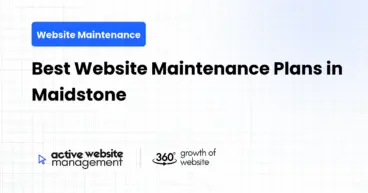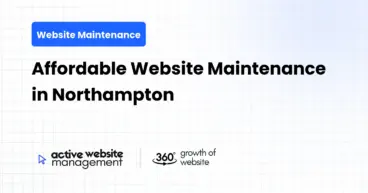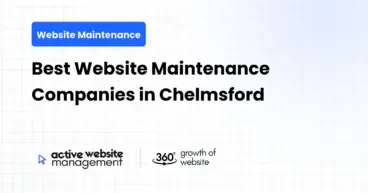February 15, 2025
16 min read
Running a custom furniture store is about more than just crafting beautiful pieces; it’s about crafting a seamless, trustworthy, and engaging online experience. Your website is your virtual showroom, the place where customers envision your creations in their homes, and ultimately, decide whether or not to invest. But just like a physical showroom needs regular upkeep, your website requires consistent maintenance to keep it performing at its best. Ignoring this vital aspect can lead to lost sales, frustrated customers, and a damaged reputation. Let’s delve into six essential website maintenance steps that every custom furniture store should prioritize.
1. Security Updates: Fortifying Your Digital Fortress
Imagine a potential customer finally finds the perfect handcrafted dining table on your site, ready to place their order, only to be greeted by a security warning. Panic sets in. They question the safety of your website and, consequently, the trustworthiness of your business. This scenario highlights the critical importance of website security, particularly in the age of rampant cyber threats. For custom furniture stores, which often handle sensitive customer data like addresses, payment information, and design preferences, security breaches can be devastating.
Why Security Updates Matter More Than Ever:
- Protecting Customer Data: Protecting your customer’s personally identifiable information (PII) is not just ethical; it’s a legal obligation under regulations like GDPR and CCPA.
- Maintaining Trust and Reputation: A security breach can shatter customer trust, leading to negative reviews and a significant drop in sales.
- Preventing Financial Losses: Cyberattacks can result in direct financial losses due to stolen funds, legal fees, and recovery costs.
- Ensuring Website Availability: Malware and hacking attempts can take your website offline, preventing customers from accessing your products and services.
- Improving SEO Ranking: Search engines like Google penalize websites with security vulnerabilities, impacting your search engine ranking.
Actionable Steps for Security Maintenance:
- Regularly Update Your CMS (Content Management System): Platforms like WordPress, Shopify, and Squarespace are constantly releasing updates to address security vulnerabilities. Install these updates promptly.
- Example: If your website is built on WordPress, ensure you have automatic updates enabled for both the core software and any plugins you use.
- Update Plugins and Themes: Outdated plugins and themes are prime targets for hackers. Regularly check for updates and remove any unused or outdated extensions.
- Tip: Before updating plugins, create a backup of your website to avoid any data loss or compatibility issues.
- Implement a Web Application Firewall (WAF): A WAF acts as a shield between your website and the internet, filtering out malicious traffic and preventing attacks.
- Example: Consider using cloud-based WAF services like Cloudflare or Sucuri.
- Use Strong Passwords and Two-Factor Authentication: Enforce strong password policies for all users with access to your website. Implement two-factor authentication (2FA) for an added layer of security.
- Strategy: Educate your team about password security best practices, emphasizing the importance of using unique and complex passwords.
- Install an SSL Certificate: An SSL (Secure Socket Layer) certificate encrypts data transmitted between your website and your visitors, protecting sensitive information like credit card details. Look for the padlock icon in the address bar of your browser.
- How-to: Contact your hosting provider or a certificate authority to purchase and install an SSL certificate.
- Regularly Scan for Malware: Use a reputable malware scanner to identify and remove any malicious software that may have infected your website.
- Recommendation: Consider using tools like Sucuri SiteCheck or Malwarebytes.
- Implement a Backup and Recovery Plan: Regularly back up your website’s files and database to a secure location. Test your recovery process to ensure you can restore your website quickly in case of a disaster.
- Best Practice: Automate your backup process to ensure consistent and reliable backups.
2. Content Updates: Keeping Your Online Showroom Fresh and Relevant
Imagine walking into a furniture store and seeing the same displays, the same fabrics, and the same styles year after year. You’d likely lose interest and assume the store is stagnating. The same principle applies to your website. Stale content can make your custom furniture store appear outdated and irrelevant. Regularly updating your website content is crucial for attracting new customers, engaging existing ones, and improving your search engine ranking.
Why Fresh Content Drives Success:
- Attracts New Customers: New content, particularly blog posts and articles, can attract new visitors to your website by targeting relevant keywords and addressing their needs.
- Engages Existing Customers: Regularly updating your website with new product announcements, design tips, and customer testimonials keeps your existing customers engaged and coming back for more.
- Improves Search Engine Ranking: Search engines prioritize websites that consistently publish fresh, high-quality content.
- Establishes Authority and Expertise: Publishing informative and valuable content positions your custom furniture store as an authority in the industry.
- Boosts Social Media Presence: Fresh content provides valuable material to share on social media, driving traffic back to your website.
Actionable Steps for Content Maintenance:
- Update Product Information: Ensure that all product descriptions, images, and pricing are accurate and up-to-date. Add new products regularly to keep your inventory fresh and exciting.
- Example: When introducing a new line of reclaimed wood furniture, create detailed product descriptions that highlight the unique characteristics of the wood and its sustainable origins.
- Create a Blog: Publish blog posts on topics relevant to your target audience, such as interior design trends, furniture care tips, and the story behind your custom furniture creations.
- Blog Ideas:
- “5 Ways to Personalize Your Home with Custom Furniture”
- “The Ultimate Guide to Choosing the Right Wood for Your Dining Table”
- “Sustainable Furniture: Making Eco-Friendly Choices for Your Home”
- Add Customer Testimonials and Reviews: Showcase positive customer feedback to build trust and credibility. Encourage customers to leave reviews on your website and social media channels.
- Strategy: Implement a system for automatically collecting and displaying customer reviews on your product pages.
- Update Your “About Us” Page: Keep your “About Us” page current with information about your team, your mission, and your values.
- Highlight: Showcase your commitment to sustainable practices or your unique design process.
- Create Videos and Infographics: Use visual content to engage your audience and communicate complex information in an easy-to-understand format.
- Video Ideas:
- “A Behind-the-Scenes Look at Our Custom Furniture Workshop”
- “How to Choose the Right Sofa for Your Living Room”
- “Customer Testimonial: [Customer Name] Shares Their Experience with [Your Brand]”
- Check for Broken Links: Regularly scan your website for broken links and fix them to ensure a seamless user experience.
- Tool Recommendation: Use a broken link checker like Broken Link Check or Dr. Link Check.
- Optimize Content for SEO: Use relevant keywords in your titles, descriptions, and body copy to improve your search engine ranking.
Imagine a customer eagerly browsing your website, ready to invest in a custom-made bed frame. But the images load slowly, the pages take forever to load, and the overall experience feels sluggish. Frustration mounts, and they eventually abandon your site, potentially heading to a competitor with a faster, more responsive website. Website performance is paramount to creating a positive user experience and maximizing conversions.
Why Website Speed Matters:
- Improved User Experience: A fast-loading website provides a seamless and enjoyable experience for your visitors.
- Higher Conversion Rates: Studies show that faster websites have higher conversion rates, as users are more likely to complete a purchase if they don’t have to wait for pages to load.
- Improved Search Engine Ranking: Google considers website speed as a ranking factor, so a faster website can improve your search engine visibility.
- Reduced Bounce Rate: A slow-loading website can lead to a higher bounce rate, as visitors are more likely to leave your site if it takes too long to load.
- Mobile-Friendliness: With the majority of internet users accessing websites on mobile devices, it’s crucial to ensure your website is optimized for mobile performance.
Actionable Steps for Performance Optimization:
- Optimize Images: Compress images to reduce file size without sacrificing quality. Use appropriate image formats like JPEG for photographs and PNG for graphics.
- Tools: Use image optimization tools like TinyPNG or ImageOptim.
- Enable Browser Caching: Browser caching allows browsers to store static assets like images and CSS files, reducing the need to download them on subsequent visits.
- How-to: Configure browser caching settings in your web server configuration file or use a caching plugin.
- Minify CSS and JavaScript: Minifying CSS and JavaScript files removes unnecessary characters and whitespace, reducing file size and improving loading speed.
- Tools: Use minification tools like CSSNano or UglifyJS.
- Use a Content Delivery Network (CDN): A CDN distributes your website’s content across multiple servers around the world, ensuring that visitors can access your website quickly regardless of their location.
- Example: Consider using CDN services like Cloudflare or Amazon CloudFront.
- Choose a Reliable Hosting Provider: A reliable hosting provider can significantly impact your website’s performance. Choose a hosting plan that meets your website’s needs and provides adequate resources.
- Recommendation: Look for hosting providers that offer features like SSD storage, caching, and CDN integration.
- Minimize HTTP Requests: Reduce the number of HTTP requests your website makes by combining CSS and JavaScript files, using CSS sprites, and avoiding unnecessary plugins.
- Technique: Analyze your website’s HTTP requests using tools like Chrome DevTools or WebPageTest.
- Regularly Test Website Speed: Use website speed testing tools to identify areas for improvement and track your progress over time.
- Tools: Use tools like Google PageSpeed Insights or GTmetrix.
Don’t Just Maintain Your Website—
Grow It using Active Website Management! Don't Wait for Growth—Accelerate It with Active Website Management
4. Mobile Optimization: Reaching Customers on the Go
Imagine a customer is browsing your custom furniture store on their smartphone while commuting to work. The website is not responsive, the text is too small to read, and the navigation is difficult to use. They quickly become frustrated and leave your website, potentially missing out on a valuable sale. In today’s mobile-first world, ensuring your website is optimized for mobile devices is no longer optional; it’s essential.
Why Mobile Optimization is Crucial:
- Increased Mobile Traffic: The majority of internet users access websites on mobile devices, making mobile optimization crucial for reaching your target audience.
- Improved User Experience: A mobile-friendly website provides a seamless and enjoyable experience for mobile users.
- Higher Conversion Rates: Mobile-optimized websites have higher conversion rates, as mobile users are more likely to complete a purchase if they can easily navigate and interact with your website.
- Improved Search Engine Ranking: Google prioritizes mobile-friendly websites in its search results, so mobile optimization can improve your search engine visibility.
- Competitive Advantage: Mobile optimization can give you a competitive advantage over businesses that haven’t optimized their websites for mobile devices.
Actionable Steps for Mobile Optimization:
- Use a Responsive Design: Responsive design allows your website to adapt to different screen sizes and devices, providing a consistent user experience across all platforms.
- Tip: Test your website on different mobile devices and screen sizes to ensure it displays correctly.
- Optimize Images for Mobile: Compress images to reduce file size without sacrificing quality. Use appropriate image formats like JPEG for photographs and PNG for graphics.
- Tools: Use image optimization tools like TinyPNG or ImageOptim.
- Use Mobile-Friendly Navigation: Simplify your website’s navigation to make it easy for mobile users to find what they’re looking for. Use a clear and concise menu that is easy to tap on a mobile device.
- Recommendation: Consider using a hamburger menu or a tabbed navigation.
- Use Large and Readable Fonts: Use fonts that are large and readable on mobile devices. Avoid using small fonts that are difficult to read on small screens.
- Best Practice: Use a font size of at least 16 pixels for body text.
- Use Touch-Friendly Buttons and Links: Make sure your buttons and links are large enough to be easily tapped on a mobile device.
- Guideline: Ensure buttons and links have a touch target size of at least 44 x 44 pixels.
- Optimize for Mobile Speed: Optimize your website for mobile speed by compressing images, minifying CSS and JavaScript, and using a content delivery network (CDN).
- Tools: Use tools like Google PageSpeed Insights or GTmetrix to identify areas for improvement.
- Test Your Website on Mobile Devices: Regularly test your website on different mobile devices to ensure it displays correctly and functions properly.
- Testing: Use a mobile device emulator or test your website on actual mobile devices.
5. SEO Maintenance: Ensuring Your Furniture Finds its Audience
Imagine pouring your heart and soul into crafting exquisite custom furniture, only to have your website buried deep within search engine results, unseen by potential customers actively searching for your services. Search Engine Optimization (SEO) is the process of optimizing your website to rank higher in search engine results pages (SERPs), making it easier for customers to find your custom furniture store online. Effective SEO is an ongoing process that requires consistent maintenance and adaptation.
Why SEO Maintenance is Essential:
- Increased Website Traffic: Higher search engine rankings lead to increased website traffic from organic search results.
- Targeted Traffic: SEO helps you attract targeted traffic from users who are actively searching for products and services related to custom furniture.
- Improved Brand Visibility: Higher search engine rankings increase your brand visibility and awareness.
- Cost-Effective Marketing: SEO is a cost-effective marketing strategy compared to paid advertising.
- Long-Term Results: SEO can provide long-term results, as your website continues to rank higher in search engine results over time.
Actionable Steps for SEO Maintenance:
- Keyword Research: Conduct ongoing keyword research to identify relevant keywords that your target audience is using to search for custom furniture.
- Tools: Use keyword research tools like Google Keyword Planner, SEMrush, or Ahrefs.
- On-Page Optimization: Optimize your website’s content, titles, and meta descriptions with relevant keywords.
- Best Practices:
- Use keywords in your title tags and meta descriptions.
- Optimize your image alt text with relevant keywords.
- Use header tags (H1, H2, H3, etc.) to structure your content and include relevant keywords.
- Content Marketing: Create high-quality, informative content that is relevant to your target audience.
- Content Ideas:
- Blog posts about interior design trends and furniture care tips.
- Case studies showcasing your custom furniture creations.
- Videos demonstrating your craftsmanship and design process.
- Link Building: Build high-quality backlinks from other reputable websites.
- Strategies:
- Guest blogging on industry-related websites.
- Participating in online communities and forums.
- Submitting your website to relevant directories.
- Technical SEO: Ensure your website is technically sound and optimized for search engines.
- Tasks:
- Check your website’s robots.txt file and sitemap.xml file.
- Ensure your website is mobile-friendly and responsive.
- Optimize your website’s loading speed.
- Monitor Your Rankings: Track your website’s rankings for relevant keywords.
- Tools: Use rank tracking tools like SEMrush or Ahrefs.
- Analyze Your Traffic: Use Google Analytics to analyze your website’s traffic and identify areas for improvement.
6. Active Website Management: Proactive Care for Long-Term Success
Imagine owning a prized antique, a family heirloom passed down through generations. You wouldn’t simply leave it exposed to the elements, neglected and forgotten. You would invest in its care, ensuring its beauty and value endure. Your website, representing your custom furniture store, deserves the same proactive attention. Active Website Management isn’t just about fixing problems as they arise; it’s about proactively maintaining and optimizing your website to ensure its long-term success.
Why Active Website Management is Essential:
- Preventative Care: Proactive maintenance can prevent minor issues from escalating into major problems, saving you time and money in the long run.
- Enhanced Security: Regular security updates and monitoring can protect your website from cyber threats and data breaches.
- Improved Performance: Ongoing performance optimization can ensure your website loads quickly and provides a seamless user experience.
- Increased Traffic and Conversions: SEO maintenance and content updates can attract more visitors to your website and convert them into customers.
- Peace of Mind: Knowing that your website is in good hands allows you to focus on other aspects of your business.
- Consistency: It’s crucial to have a consistent process of monitoring website for uptime, error codes, etc.
Key Components of Active Website Management:
- Regular Monitoring: Continuously monitor your website for uptime, performance issues, and security threats.
- Tools: Use website monitoring tools like UptimeRobot or Pingdom.
- Proactive Updates: Regularly update your CMS, plugins, and themes to address security vulnerabilities and improve performance.
- Performance Optimization: Continuously optimize your website’s performance by compressing images, minifying CSS and JavaScript, and using a CDN.
- Security Hardening: Implement security measures to protect your website from cyber threats, such as installing a web application firewall (WAF) and using strong passwords.
- Backup and Recovery:Regularly back up your website’s files and database to a secure location and test your recovery process to ensure you can restore your website quickly in case of a disaster.
- SEO Maintenance: Continuously optimize your website for search engines by conducting keyword research, optimizing your content, and building backlinks.
- Content Updates: Regularly update your website’s content with new product information, blog posts, and customer testimonials.
Who Needs Active Website Management?
Every custom furniture store with an online presence can benefit from Active Website Management, especially:
- Businesses with Limited Technical Expertise: If you don’t have the technical skills or time to manage your website yourself, outsourcing it to a professional website management service can be a smart investment.
- Businesses that Rely on their Website for Revenue: If your website is a key source of leads or sales, it’s crucial to ensure it’s always up and running and performing at its best.
- Businesses that Value Security and Reliability: If you’re concerned about security breaches or website downtime, Active Website Management can provide peace of mind.
Active Website Management: provides comprehensive website maintenance and support services that can help you keep your website secure, performant, and up-to-date.
Conclusion:
Maintaining a website for a custom furniture store is an ongoing process that requires attention to detail, technical expertise, and a commitment to providing a positive user experience. By following these six essential steps, you can ensure your website is secure, performant, and optimized for search engines, attracting more customers and driving sales. Neglecting these steps can lead to lost revenue, damage to your reputation, and a frustrating experience for your customers. Invest in your website, and it will invest in your success.






